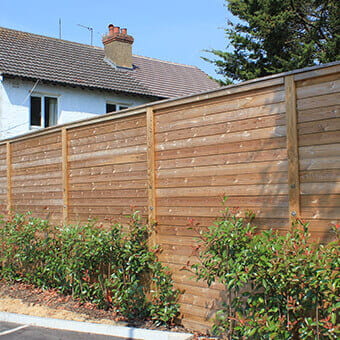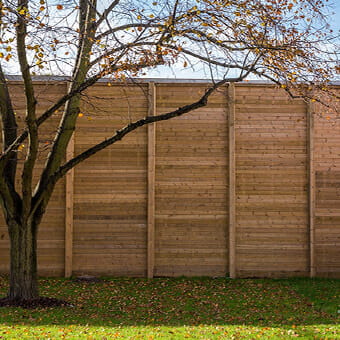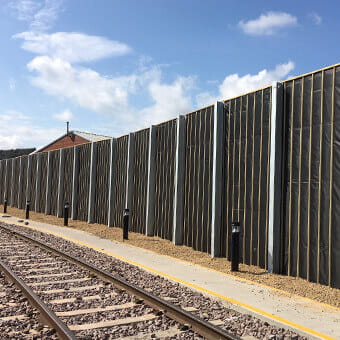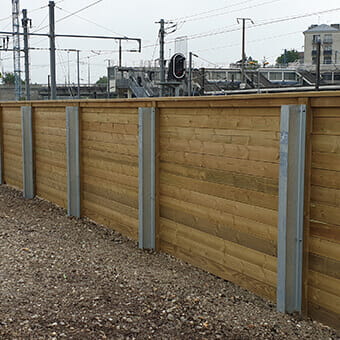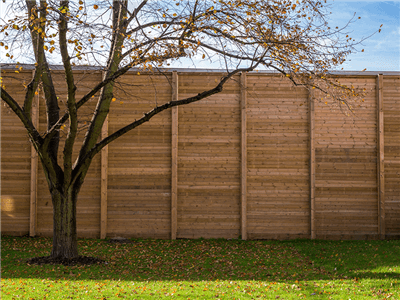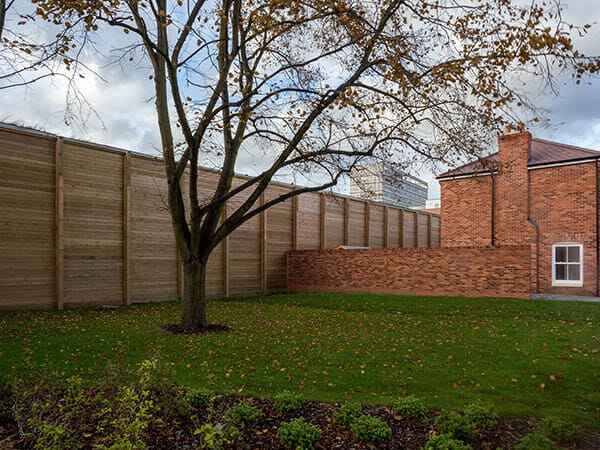Our other sites:
As the modern world is more densely populated than ever before, it’s no surprise that acoustic fencing is increasingly in demand. From noisy neighbours to traffic, we’re often surrounded by unwanted noise. With recent World Health Organisation (WHO) studies suggesting noise pollution can impact both mental wellbeing and physical health, it’s essential to understand the types of noise barriers that can offer some precious peace and quiet.
Noise barriers must be generally imperforate to prevent any sound passing through gaps (hit and miss or slatted fencing types, for example, would not be effective noise barriers), and should have a minimum mass of 10kg/m2 as noise may pass through lighter materials. As well as the potential to block sound, it’s worth considering other factors such as aesthetics, privacy, size, cost, and maintenance. For example, earth bunds and timber acoustic fencing blend easily into the natural environment and work well for residential properties, while concrete and steel barriers may be better suited to industrial sites.
Timber noise barriers
The attractive natural appearance and easy installation of timber noise barriers makes them suitable for most sites (particularly schools, homes and commercial areas), as they appear similar to a timber garden fence, whilst offering up to a 32dB reduction in noise. A deep V tongue and groove style fence prevents sound travelling through the barrier and also offers privacy.
Timber acoustic barriers also offer increased security with an anti-climb flat profile, and can be combined with steel for high security applications. Their versatility also extends to noise performance, as timber barriers can be either reflective, or have an additional absorptive layer on one side. They can also be UKCA marked as a system for road noise.
Timber barriers should be made from kiln-dried, pressure-treated timber to ensure minimal maintenance and durability, and should come with a long guarantee. As timber remains imperforate, timber noise barriers will perform well for many years.
If you have decided that you want timber noise barriers, read our other blog post on the types of timber noise barriers and their applications, or try our comparison tool .
Metal noise barriers
Metal barriers are strong, sturdy, and generally offer up to a 28dB reduction in noise. For the barrier to work effectively, the barrier should have a minimum mass of 10kg/m2 to prevent any unwanted sound leaking through.
Like the timber types, metal noise barriers are available as both reflective and absorptive, although the reflective can create an echo effect in some applications. Metal noise barriers are better suited to commercial or industrial sites, as they are slightly less welcoming in appearance than timber barriers, and it’s worth remembering a coastal location would require a marine coating on the barrier to prevent rust.
Concrete noise barriers
Concrete’s negative environmental impact puts many people off choosing this material for noise barriers, but they do offer some benefits such as high performance and being easy to construct. Concrete noise barriers can be more expensive than other noise barriers, such as timber, and are highly obtrusive due to the height and thickness required for effective noise reduction, which is generally around 50dB.
Brick noise barriers
Similarly to concrete, brick noise barriers can be expensive but are far more aesthetically pleasing than their concrete equivalent. With a long installation time required for brick noise barriers, and specialist bricklayers, this can become costly on larger sites, but their noise reduction potential is around 40dB.
Acrylic/Perspex noise barriers
Where visibility through a barrier is required, and privacy is less of a concern, acrylic and Perspex noise barriers are an ideal solution. The smooth, flat surface of the material offers built-in security as it is naturally difficult to climb, and off-putting to potential intruders. While acrylic and Perspex make for strong noise barriers; reducing noise by up to 32dB, they can be susceptible to warping.
Gabion walls
Gabion walls are an attractive, robust and cost-effective boundary marker for a range of applications. As a noise barrier, gabion walls can be highly effective but require both thickness and height, which can make the wall visually prominent, rather than blending into its surroundings. A one metre thick wall can reduce noise by up to 60dB.
The gabion baskets or cages that make up the wall are constructed from wire mesh, which are susceptible to rust and can also entangle litter and debris, so regular maintenance is required. The mesh can also be used as a foothold, making gabion walls easier to climb and less secure.
Earth bunds
Earth bunds are simply large mounds of earth placed at the perimeter of a site; they are often used to direct water flow but are also an effective noise barrier. As earth bunds require a large amount of space, architects or developers may prefer more compact noise barriers, such as fencing. Earth bunds also require maintenance to cut back plant growth, particularly next to roads, although this offers an attractive, natural appearance.
With such a wide range of noise barriers to choose from, it is a challenge to be certain which is the best for your site. The Jacksons Fencing range of acoustic fencing solutions offer noise reduction for applications including residential, commercial and industrial sites as well as railway and highway boundaries. To find out more about our acoustic fencing and noise barriers, contact us today, or watch the video below for more information on the types of noise barriers we manufacture.
Related products
Jacksons Security has a range of products relating to this article, all complete with our 25 year service life guarantee. If you cannot find the item you are looking for, please do not hesitate to call our friendly sales team.
Related Content
Top
